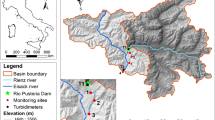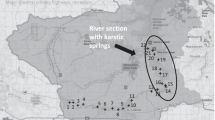Abstract
Slackwater habitats within lowland rivers support abundant biotic communities and provide these communities with a refuge from increases in discharge. These refuges allow biota to persist as discharges, vary and provide a source of colonists for slackwaters further downstream. In order to investigate the response of slackwater benthic microfaunal communities to changes in discharge, artificial slackwaters were created within the main channel of a lowland river and benthic microfaunal communities were sampled over a 60-day period. Benthic microfauna within the artificial and reference slackwaters were recorded in higher richness and abundance than in the main river channel. Within days the communities in the artificial slackwaters were similar to those in the reference slackwaters. The rapid speed of colonisation suggests that initial colonisation of slackwaters is likely to occur via active or passive dispersal of biota and that these systems and communities are resilient to changes in discharge.







Similar content being viewed by others
References
Anderson, M. J., 2006. Distance-based tests for homogeneity of multivariate dispersions. Biometrics 62: 245–253.
Anderson, M. J., R. N. Gorley & K. R. Clarke, 2008. Permanova+ for Primer: Guide to Software and Statistical Methods. PRIMER-E, Plymouth, UK.
Bass, J. A., L. C. V. Pinder & D. V. Leach, 1997. Temporal and spatial variation in zooplankton populations in the river Great Ouse: an ephemeral food resource for larval and juvenile fish. Regulated Rivers Research and Management 13: 245–258.
Bowen, Z. H., K. D. Bovee & T. J. Waddle, 2003. Effects of flow regulation on shallow-water habitat dynamics and floodplain connectivity. Transactions of the American Fisheries Society 132: 809–823.
Casper, A. F. & J. H. Thorp, 2007. Diel and lateral patterns of zooplankton distribution in the St. Lawrence river. River Research and Applications 23: 73–85.
Chapman, M. G., A. J. Underwood & G. A. Skilleter, 1995. Variability at different spatial scales between a subtidal assemblage exposed to the discharge of sewage and two control assemblages. Journal of Experimental Marine Biology and Ecology 189: 103–122.
Clarke, K. R. & R. M. Warwick, 2001. Change in Marine Communities: An Approach to Statistical Analysis and Interpretation, 2nd ed. PRIMER-E, Plymouth, UK.
Evans, W. A., 1984. Seasonal abundances of the psammic rotifers of a physically controlled stream. Hydrobiologia 108: 105–114.
Gawne, B., R. Cook, H. Gigney, J. Hawking, A. Mitchell, D. L. Nielsen & G. Watson, 2005. Successional processes in lowland river slackwaters. Final Report for CRC Freshwater Ecology Project A240: Quantifying flow habitat biota relationships in riverine ecosystems.
Golladay, S. W. & C. L. Hax, 1995. Effects of an engineered flow disturbance on meiofauna in a North Texas Prairie Stream. Journal of the North American Benthological Society 14: 404–413.
Humphries, P., R. A. Cook, A. J. Richardson & L. G. Serafini, 2006. Creating a disturbance: manipulating slackwaters in a lowland river. River Research and Applications 22: 525–542.
Jenkins, K. M. & A. J. Boulton, 2003. Connectivity in a dryland river: short term aquatic microinvertebrate recruitment following floodplain inundation. Ecology 84: 2708–2723.
King, A. J., 2004. Density and distribution of potential prey for larval fish in the main channel of a floodplain river: pelagic versus epibenthic meiofauna. River Research and Applications 20: 883–897.
Lair, N., 2006. A review of regulation mechanisms of metazoan plankton in riverine ecosystems: aquatic habitat versus biota. River Research and Applications 22: 567–593.
Lancaster, J. & A. G. Hildrew, 1993. Characterising in-stream flow refugia. Canadian Journal of Fisheries and Aquatic Sciences 50: 1663–1675.
Marsh-McBirney, 1990. Flo-Mate Model 2000 Portable Flow Meter Instruction Manual. Marsh-McBirney Inc., Frederick, MD.
Nielsen, D. L. & G. Watson, 2008. The response of epibenthic rotifers and microcrustacean communities to flow manipulations in lowland rivers. Hydrobiologia 603: 117–128.
Nielsen, D. L., R. J. Shiel & F. J. Smith, 1998. Ecology versus taxonomy: is there a middle ground? Hydrobiologia 387(388): 451–457.
Nielsen, D. L., G. Watson & R. Petrie, 2005. Microfaunal communities in three lowland rivers under differing flow regimes. Hydrobiologia 543: 101–111.
Ning, N. S. P., 2008. The ecology of microinvertebrate fauna in a temperate Australian floodplain river. PhD thesis. La Trobe University, Australia.
Ning, N. S. P., D. L. Nielsen, W. L. Paul, T. J. Hillman & P. J. Suter, 2009. Microinvertebrate dynamics in riverine slackwater and mid-channel habitats in relation to physico-chemical parameters and food availability. River Research and Applications. doi:10.1002/rra.1266.
Palmer, M. A., 1990. Understanding the movement dynamics of a stream-dwelling meiofauna community using marine analogs. Stygologia 5: 67–74.
Palmer, M. A., A. E. Bely & K. E. Berg, 1992. Response of invertebrates to lotic disturbance: a test of the hyporheic refuge hypothesis. Oecologia 89: 182–194.
Reynolds, C. S., P. A. Carling & K. J. Beven, 1991. Flow in river channels: new insights into hydraulic retention. Archiv für Hydrobiologie 121: 171–179.
Ricci, C. & M. Balsamo, 2000. The biology and ecology of lotic rotifers and gastrotrichs. Freshwater Biology 44: 15–28.
Richardson, W. B., 1991. Seasonal dynamics, benthic habitat use, and drift of zooplankton in a small stream in southern Oklahoma. U.S.A. Canadian Journal of Zoology 69: 748–756.
Richardson, W. B., 1992. Microcrustacea in flowing water: experimental analysis of washout times & a field test. Freshwater Biology 28: 217–230.
Rossetti, G., P. Viaroli & I. Ferrari, 2009. Role of abiotic and biotic factors in structuring the metazoan plankton community in a lowland river. River Research and Application 25: 814–835.
Saunders, J. F. & W. M. J. Lewis, 1988. Zooplankton abundance and transport in a tropical white-water river. Hydrobiologia 162: 147–155.
Schiemer, F., H. Kechkeis, W. Reckendorfer & G. Winkler, 2001. The “inshore retention concept” and its significance for large rivers. Archiv für Hydrobiologie Supplement 135: 509–516.
Shiel. R. J., 1995. A guide to identification of rotifers, cladocerans and copepods from Australian inland waters. Identification guide No. 3. Canberra, Cooperative Research Centre for Freshwater Ecology.
Speas, D. W., 2000. Zooplankton density and community composition following an experimental flood in the Colorado River, Grand Canyon, Arizona. Regulated Rivers Research & Management 16: 73–81.
Thorp, J. H. & A. F. Casper, 2003. Importance of biotic interactions in large rivers: an experiment with planktivorous fish, dreissenid mussels and zooplankton in the St. Lawrence River. River Research & Applications 19: 265–279.
Underwood, A. J., 1997. Experiments in Ecology: Their Logical Design and Interpretation Using Analysis of Variance. University Press, Cambridge.
Warwick, R. M. & K. R. Clarke, 1993. Increased variability as a symptom of stress in marine communities. Journal of Experimental Marine Biology and Ecology 172: 215–226.
Williams, J., A. Mitchell & B. Gawne, 2005. A review of historic monitoring (river health and water quality) and research within the Broken River system. A report prepared for the Goulburn Broken Catchment Management Authority by the Murray-Darling Freshwater Research Centre.
Acknowledgements
This project was a component of an integrated research project investigating lowland rivers in Australia funded by the Cooperative Research Centre for Freshwater Ecology and supported by the Murray-Darling Freshwater Research Centre. The authors thank the lowland river project team for their assistance with field work. The manuscript has been greatly improved in response to comments from Dr Gavin Rees and Dr Nathan Ning.
Author information
Authors and Affiliations
Corresponding author
Additional information
Handling editor: Karl E. Havens
Rights and permissions
About this article
Cite this article
Nielsen, D.L., Gigney, H. & Watson, G. Riverine habitat heterogeneity: the role of slackwaters in providing hydrologic buffers for benthic microfauna. Hydrobiologia 638, 181–191 (2010). https://doi.org/10.1007/s10750-009-0039-8
Received:
Revised:
Accepted:
Published:
Issue Date:
DOI: https://doi.org/10.1007/s10750-009-0039-8




